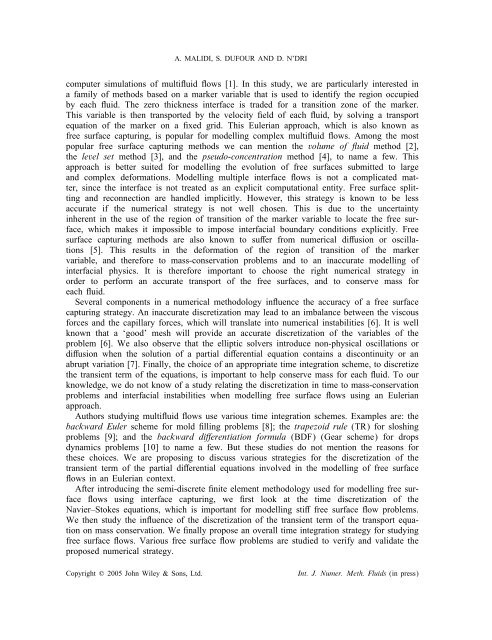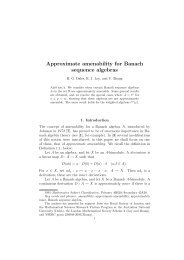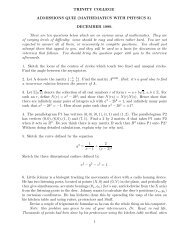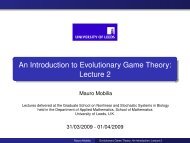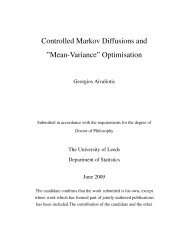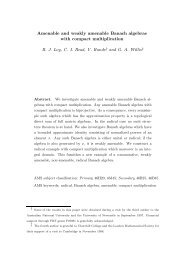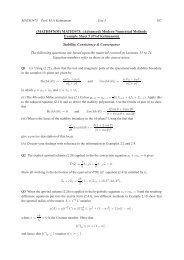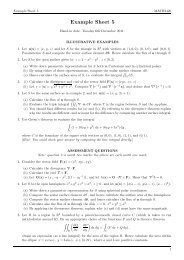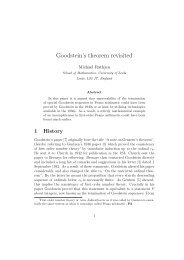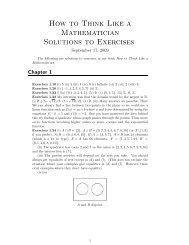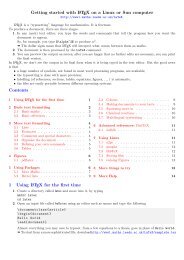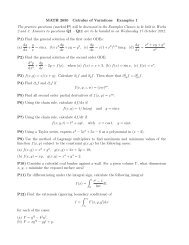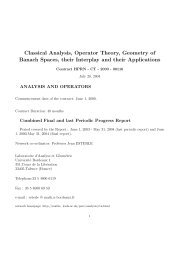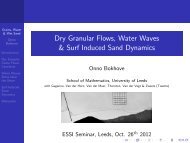A study of time integration schemes for the numerical modelling of ...
A study of time integration schemes for the numerical modelling of ...
A study of time integration schemes for the numerical modelling of ...
You also want an ePaper? Increase the reach of your titles
YUMPU automatically turns print PDFs into web optimized ePapers that Google loves.
A. MALIDI, S. DUFOUR AND D. N’DRIcomputer simulations <strong>of</strong> multiuid ows [1]. In this <strong>study</strong>, we are particularly interested ina family <strong>of</strong> methods based on a marker variable that is used to identify <strong>the</strong> region occupiedby each uid. The zero thickness interface is traded <strong>for</strong> a transition zone <strong>of</strong> <strong>the</strong> marker.This variable is <strong>the</strong>n transported by <strong>the</strong> velocity eld <strong>of</strong> each uid, by solving a transportequation <strong>of</strong> <strong>the</strong> marker on a xed grid. This Eulerian approach, which is also known asfree surface capturing, is popular <strong>for</strong> <strong>modelling</strong> complex multiuid ows. Among <strong>the</strong> mostpopular free surface capturing methods we can mention <strong>the</strong> volume <strong>of</strong> uid method [2],<strong>the</strong> level set method [3], and <strong>the</strong> pseudo-concentration method [4], to name a few. Thisapproach is better suited <strong>for</strong> <strong>modelling</strong> <strong>the</strong> evolution <strong>of</strong> free surfaces submitted to largeand complex de<strong>for</strong>mations. Modelling multiple interface ows is not a complicated matter,since <strong>the</strong> interface is not treated as an explicit computational entity. Free surface splittingand reconnection are handled implicitly. However, this strategy is known to be lessaccurate if <strong>the</strong> <strong>numerical</strong> strategy is not well chosen. This is due to <strong>the</strong> uncertaintyinherent in <strong>the</strong> use <strong>of</strong> <strong>the</strong> region <strong>of</strong> transition <strong>of</strong> <strong>the</strong> marker variable to locate <strong>the</strong> free surface,which makes it impossible to impose interfacial boundary conditions explicitly. Freesurface capturing methods are also known to suer from <strong>numerical</strong> diusion or oscillations[5]. This results in <strong>the</strong> de<strong>for</strong>mation <strong>of</strong> <strong>the</strong> region <strong>of</strong> transition <strong>of</strong> <strong>the</strong> markervariable, and <strong>the</strong>re<strong>for</strong>e to mass-conservation problems and to an inaccurate <strong>modelling</strong> <strong>of</strong>interfacial physics. It is <strong>the</strong>re<strong>for</strong>e important to choose <strong>the</strong> right <strong>numerical</strong> strategy inorder to per<strong>for</strong>m an accurate transport <strong>of</strong> <strong>the</strong> free surfaces, and to conserve mass <strong>for</strong>each uid.Several components in a <strong>numerical</strong> methodology inuence <strong>the</strong> accuracy <strong>of</strong> a free surfacecapturing strategy. An inaccurate discretization may lead to an imbalance between <strong>the</strong> viscous<strong>for</strong>ces and <strong>the</strong> capillary <strong>for</strong>ces, which will translate into <strong>numerical</strong> instabilities [6]. It is wellknown that a ‘good’ mesh will provide an accurate discretization <strong>of</strong> <strong>the</strong> variables <strong>of</strong> <strong>the</strong>problem [6]. We also observe that <strong>the</strong> elliptic solvers introduce non-physical oscillations ordiusion when <strong>the</strong> solution <strong>of</strong> a partial dierential equation contains a discontinuity or anabrupt variation [7]. Finally, <strong>the</strong> choice <strong>of</strong> an appropriate <strong>time</strong> <strong>integration</strong> scheme, to discretize<strong>the</strong> transient term <strong>of</strong> <strong>the</strong> equations, is important to help conserve mass <strong>for</strong> each uid. To ourknowledge, we do not know <strong>of</strong> a <strong>study</strong> relating <strong>the</strong> discretization in <strong>time</strong> to mass-conservationproblems and interfacial instabilities when <strong>modelling</strong> free surface ows using an Eulerianapproach.Authors <strong>study</strong>ing multiuid ows use various <strong>time</strong> <strong>integration</strong> <strong>schemes</strong>. Examples are: <strong>the</strong>backward Euler scheme <strong>for</strong> mold lling problems [8]; <strong>the</strong> trapezoid rule (TR) <strong>for</strong> sloshingproblems [9]; and <strong>the</strong> backward dierentiation <strong>for</strong>mula (BDF) (Gear scheme) <strong>for</strong> dropsdynamics problems [10] to name a few. But <strong>the</strong>se studies do not mention <strong>the</strong> reasons <strong>for</strong><strong>the</strong>se choices. We are proposing to discuss various strategies <strong>for</strong> <strong>the</strong> discretization <strong>of</strong> <strong>the</strong>transient term <strong>of</strong> <strong>the</strong> partial dierential equations involved in <strong>the</strong> <strong>modelling</strong> <strong>of</strong> free surfaceows in an Eulerian context.After introducing <strong>the</strong> semi-discrete nite element methodology used <strong>for</strong> <strong>modelling</strong> free surfaceows using interface capturing, we rst look at <strong>the</strong> <strong>time</strong> discretization <strong>of</strong> <strong>the</strong>Navier–Stokes equations, which is important <strong>for</strong> <strong>modelling</strong> sti free surface ow problems.We <strong>the</strong>n <strong>study</strong> <strong>the</strong> inuence <strong>of</strong> <strong>the</strong> discretization <strong>of</strong> <strong>the</strong> transient term <strong>of</strong> <strong>the</strong> transport equationon mass conservation. We nally propose an overall <strong>time</strong> <strong>integration</strong> strategy <strong>for</strong> <strong>study</strong>ingfree surface ows. Various free surface ow problems are studied to verify and validate <strong>the</strong>proposed <strong>numerical</strong> strategy.Copyright ? 2005 John Wiley & Sons, Ltd.Int. J. Numer. Meth. Fluids (in press)


